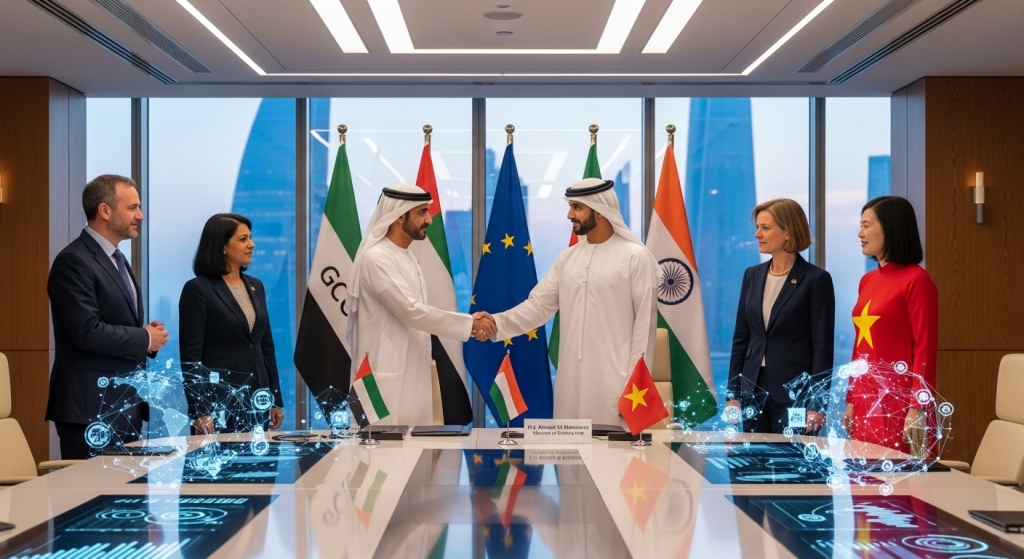Introduction
The United Arab Emirates (UAE) continues to solidify its position as a global trade hub with the recent announcement of new trade partnerships aimed at enhancing economic ties within the Gulf region and beyond. These partnerships are expected to foster collaboration, drive investment, and create a more integrated economic landscape. In this article, we will explore the implications of these new trade agreements, the sectors likely to benefit, and the strategic vision behind this initiative.
Overview of Recent Trade Partnerships
In a series of high-level meetings, UAE officials have engaged with representatives from various countries to establish trade agreements that will facilitate smoother exchange of goods, services, and investments. These partnerships are part of a broader strategy to diversify the UAE’s economy, reduce dependency on oil, and enhance its global competitiveness.
Key Trade Agreements
Some of the notable trade agreements include:
- Gulf Cooperation Council (GCC) Expansion: The UAE is working to strengthen ties with other GCC countries, focusing on reducing tariffs and enhancing trade facilitation measures.
- Partnerships with Asian Markets: Agreements with countries like India and Vietnam are being prioritized to boost exports and imports, particularly in technology and agriculture.
- European Union Collaboration: The UAE aims to enhance trade relations with EU member states, focusing on sectors such as renewable energy and technology.
Benefits of Strengthened Trade Ties
The establishment of new trade partnerships is expected to yield several benefits for the UAE economy:
1. Economic Diversification
By enhancing trade with various countries, the UAE can reduce its reliance on oil revenues and promote sectors such as tourism, technology, and manufacturing. This diversification is crucial for sustainable growth in the long term.
2. Increased Foreign Direct Investment (FDI)
New trade agreements are likely to attract foreign investors looking to capitalize on the UAE’s strategic location and business-friendly environment. This influx of capital can lead to job creation and innovation.
3. Enhanced Competitiveness
With improved access to international markets, UAE businesses can become more competitive. This can result in lower prices for consumers and higher quality products and services.
4. Strengthened Regional Ties
By fostering closer economic relationships with neighboring countries, the UAE can play a pivotal role in regional stability and cooperation. This can lead to joint ventures and collaborative projects that benefit all parties involved.
Strategic Vision Behind the Trade Partnerships
The UAE’s leadership has articulated a clear vision for the future of the economy, emphasizing the importance of innovation, sustainability, and global integration. The recent trade partnerships align with this vision in several ways:
1. Vision 2021
The UAE’s Vision 2021 aims to make the country one of the best in the world by focusing on a diversified economy, a competitive knowledge economy, and a sustainable environment. The new trade partnerships directly support these goals.
2. Economic Development Plans
The UAE has outlined specific economic development plans that prioritize sectors such as technology, renewable energy, and logistics. The new trade agreements are designed to facilitate growth in these areas.
3. Global Trade Leadership
By establishing itself as a leader in global trade, the UAE aims to attract businesses and talent from around the world. This leadership role can enhance the country’s reputation and influence on the international stage.
Challenges and Considerations
While the new trade partnerships present numerous opportunities, there are also challenges that need to be addressed:
1. Regulatory Hurdles
Different regulatory environments can complicate trade agreements. The UAE will need to work closely with partner countries to harmonize regulations and ensure smooth trade flows.
2. Economic Uncertainties
The global economic landscape is constantly changing, and factors such as geopolitical tensions and economic downturns can impact trade relationships. The UAE must remain agile and responsive to these changes.
3. Infrastructure Development
To fully capitalize on new trade opportunities, the UAE will need to invest in its infrastructure, including ports, logistics, and transportation networks. This investment is essential for facilitating efficient trade.
Conclusion
The UAE’s commitment to enhancing trade partnerships is a strategic move that promises to bolster its economy and strengthen regional ties. As the country continues to diversify its economy and position itself as a global trade leader, these partnerships will play a crucial role in shaping the future of business in the region. By addressing the challenges and leveraging the opportunities, the UAE can ensure sustainable economic growth and prosperity for its citizens.
For more insights on business opportunities and investment in the UAE, visit Persian Horizon.
Source: https://www.emirates247.com/business










